
Rosana Antolí (Alcoi, 1981) defines her practice as the “attempt to reveal the choreographies that structure our daily lives”. A prolific artist with an extremely motivated (and motivating) personality, Antolí has developed her career in Spain, Germany and the United Kingdom, including artist residencies in Argentina, Colombia and Switzerland.
Rosana Antolí (Alcoi, 1981) defines her practice as the “attempt to reveal the choreographies that structure our daily lives”.
A prolific artist with an extremely motivated (and motivating) personality, Antolí has developed her career in Spain, Germany and the United Kingdom, including artist residencies in Argentina, Colombia and Switzerland.
Having worked with a diversity of media, mainly drawing and installation, in the last few years her interest seems to have found its focused on a thorough investigation of everyday gestures and movements. She decodes this in the language of choreography and sound.
It is perhaps in this shift in her career, along with the years of experimental practice and the fact of being one of the winners of the prestigious Spanish award for emergent artists, Generaciones, that has resulted in her increasing presence in the media and at international exhibitions.
We talk with the Valencian artist to learn more about her vision for artistic practices that demand a mathematical and rational production through poetic and slow-paced perspectives.
ArtDependence Magazine: When did you decide to become an artist?
Rosana Antolí: The decision to become an artist felt like a very strong slap inside me. When I was 18 I was studying Science at University and I went to see an art exhibition in Barcelona with my father. Maths and arts both have a kind of abstract thinking in common. I have always been attracted to that.
In that exhibition, I remember observing a group of people in front of a painting, looking at it in pause, in silence. I got closer and suddenly I felt something very strong in my stomach, something that makes you stop and travel without moving. Immediately I knew I wanted to be able to do what the painting was doing to me. I am very stubborn, so ever since that moment I have been following this path.
AD: Some of your references are minimalist musicians and performers from the 70’s. How do you integrate their influence in your work?
RA: For the constructions of some audios, paintings or sculptures I have the minimalist musicians of the 70s, like Philip Glass or Steve Reich, as reference. This is because I am very interested in the research around repetition and the basic essence of movement.
I revisit some old masters of performance and dance like Allan Kaprow, Trisha Brown or Merce Cunningham with the techniques of today.
Rhythm theorists like Laban and Lefebvre help me in my research, putting together choreography, the everyday and visual arts. For example, Lefebvre’s notions of circular time, and its relationship with the rhythm of our mundane, and how this could be measured through repetition. Repetition causes a rhythm and also a time.
For more specific projects like ‘Virtual Choreography’, I have more clear references, such ‘One Minute Sculptures’ from artist Erwin Wurm. I work with people, isolating our everyday gestures and repeating them in a one minute loop. As result I have created my ‘One Minute Social Choreography’.
I recently discovered the work of Ericka Beckman, which I found profoundly inspiring for my own practice in the way she explores the relationship of choreography and movement with music, narrative and sculptural objects.
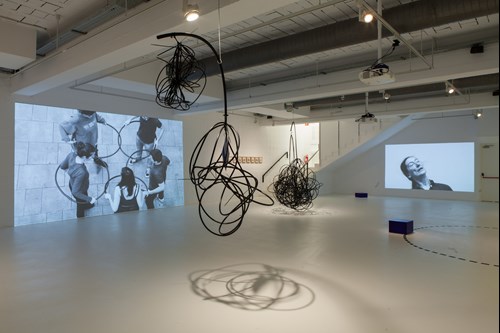
Rosana Antoli. Cuando las lineas son tiempo. Espai 13. Fundacio Joan Miro. Barcelona. 2016
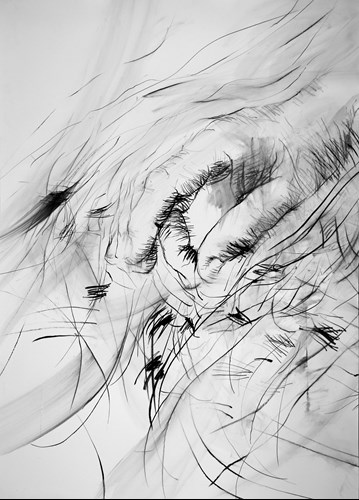
Rosana Antoli. D1. 143 X 103 cm. Chalk and Paint. 2017
AD: The main mediums you use to create your works are movement and urban gestures. Does the use of these media define the work itself, or are they simply a vehicle to tell a story?
RA: The Spanish artist Juan Muñoz defined himself as a storyteller, and I have total empathy with this statement. The narrative element in my work is very present, even if the narrative is not visible or is broken. In this narrative, I have conceptual research related to each work I do.
Gestures construct our identity, which can change depending on our environment and
culture. Therefore, gestures have a political and social charge depending on their paradigm. The gesture can be examined as a space of resistance, engaging with transformative grammar and current expressive codes.
All the media I use in my work: painting, drawing, video, sculpture or performance are, at the end, vehicles to tell a story.
AD: One of your most iconic works is Chaos Dancing Cosmos. What does this work mean to you?
RA: Chaos Dancing Cosmos is a site-specific installation with rubber and motors, where a precise drawing or trace is translated into the three-dimensional space.
For me, it meant an inflexion moment in my practice because it was a risk, both in the use of this specific material and also in working with it in such a constructive and changing process for the sculptures. The result was even better than the image in my mind, and because of its flexibility, I can reflect on the space and architecture where I relate this work to the movements developed there, creating this whole universe of lines in space.
AD: Tell us about your most recent work or exhibition?
RA: I was invited to do a solo show at Espai 13 at Joan Miro Foundation in Barcelona in 2016. It was part of the exhibition programme ‘When lines are time’ which was curated by Martí Manen. Manen and I started to work with the concepts of time and space, and on how to push my artistic practice around the concept of ‘movement’. We got to the question: ‘how can we endurance a movement, a moment, that we know is going to finish?’
It’s all about an epic gesture condemned to fail beforehand. How can we try, with a body, to perform an infinite movement?
I created the exhibition with different mediums like painting, drawing, sculptures, videos, or performance that were part, among others, of the same choreography. I used the exhibition space like a canvas, where each object or movement registered on it played a part of a collective symphony. The sculptures in the museum had repetitive movements, the videos were in loop, and I also organised weekly open-door interventions in the space for any external agents’ collaboration. There was a rhythm that was not broken during the whole exhibition period.
My last exhibition in London was at Zabludowicz Collection during November 2017. It was part of the 10th anniversary celebrations. I was invited to do a performance with the band Tomaga, with whom I’ve been working closely in my last exhibitions. We had a one week residency at the foundation and the final performative event. The objective was to respond to Haroon Mirza’s work and to create a dialogue with him.
‘Whale Harmonies’ is the biggest performance I have choreographed, with 8 performers, video and live music. It was a performance in three parts, influenced by how the vast harmonies of the Solar System’s planetary choreography are entwined with the repeated minimal movements that comprise our daily habits and rituals. The performance takes the film Werckmeister Harmonies by director Béla Tarr as a key reference point.
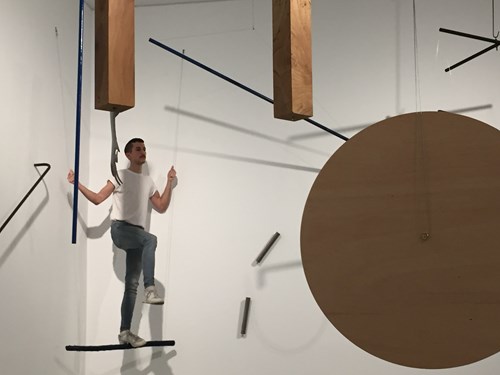
Rosana Antoli. Premio Generaciones 2. Photo Sara Navarro
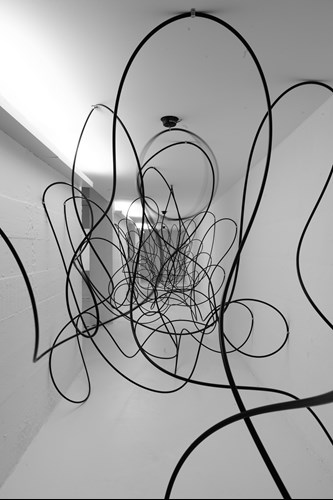
Rosana Antoli. Quan les linies son Temps BN. Solo Show. Fundacio Joan Miro. Barcelona. 2016 (ALTA)
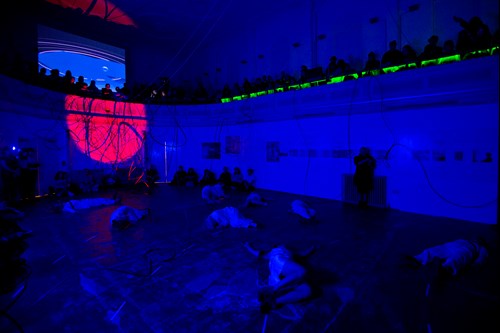
Rosana Antoli. Whale Harmonies. Zabludowicz Collection. Performance. London. 2017
AD: What do you need to have in your studio or working space to work the way you want?
RA: Space, windows, many different materials and a computer. I need to listen to music and write while I’m working, I need to move and move my work, I need to get messy. And I need to look through the window and see outside the studio, outside my head.
AD: How does the city where you live influence your work and practice?
RA: I eat in London, I digest in my Mediterranean mountains. Both processes are necessary to me. Each city that invites me to exhibit has an influence on my work, because I tend to walk the space where I live, embrace the new cultures and see how I can be enriched by it or how to question the principles of the project I’m doing there.
AD: What are your current interests in relation to your artistic practice?
RA: I am researching the way architecture and technology define our context and what their influence is on how we move, and therefore how this influences our everyday gestures.
I recently started to work in relation to Contemporary Opera, exploring how the performance, live music, sculptures, paintings and video as scenography, could relate to a kind of ‘complete work’ or ‘total choreographed exhibition’.
AD: What do you dislike about the art world?
RA: The fast art eaters.
AD: What living artist do you admire?
William Kentridge, Philip Glass, Francis Alys, William Forsythe, Ericka Beckman, Teresa de Keersmaeker, Esther Ferrer...
Image on top: ©Peter Calvin Silvertown

ArtDependence Magazine is an international magazine covering all spheres of contemporary art, as well as modern and classical art.
ArtDependence features the latest art news, highlighting interviews with today’s most influential artists, galleries, curators, collectors, fair directors and individuals at the axis of the arts.
The magazine also covers series of articles and reviews on critical art events, new publications and other foremost happenings in the art world.
If you would like to submit events or editorial content to ArtDependence Magazine, please feel free to reach the magazine via the contact page.